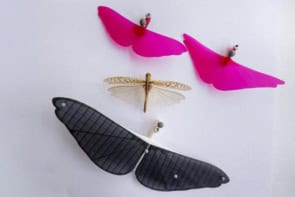
Measuring the vital signs of small conscious animals is important for assessing their health and behaviour. Current monitoring techniques, such as electrocardiograms (ECG), ultrasound and auscultation (listening to heart and breath sounds), however, rely on close skin contact with the animal and other invasive approaches. Such methods can cause discomfort or stress to animals and may even require anaesthesia, particularly for birds, reptiles and fish.
To address this problem, Xiaonan Hui and Edwin Kan from Cornell University are developing a less invasive way to monitor the health of small animals, based on radio-frequency (RF) near-field coherent sensing (NCS). They note that this approach has minimal impact on the daily rhythms of the animal, with most unlikely to even notice the ongoing measurements (Science Advances 10.1126/sciadv.aau0169).
Hui and Kan investigated two NCS setups. The first involves a wireless system that uses a harmonic RF identification (RFID) architecture with inexpensive passive sensing tags. In this setup, a harmonic reader transmits the downlink signal at a frequency, f, through the reader transmit antenna. This signal powers up a passive harmonic RFID tag placed in the vicinity of the animal and is converted to a second-harmonic frequency at 2f (the NCS sensing signal).
As long as the animal is within the near-field range of the sensing tag antenna, motion on and inside its body is coupled to the backscattered signal and sent to the harmonic reader’s receive antenna. This approach, deployable without need of maintenance, is suitable for use in the animals’ natural habitats with weather-proof RFID tags and the reader placed nearby.
The second approach replaces the wireless links between the reader and the harmonic tag with RF cables. Here, the harmonic reader transmits the NCS sensing signal directly at 2f and is placed in the near-field range of the animal under test. The NCS signal modulated by the animal’s vital signs is received by the reader antenna. This design reduces interference and is appropriate for deployment in an indoor laboratory.
To compare their NCS approach to current monitoring methods, Hui and Kan first performed synchronized NCS and ECG measurements on an anesthetized rat. The heartbeat intervals extracted from NCS and ECG data matched very closely. The researchers suggest that NCS is sufficiently accurate to replace ECG for behaviour studies based on heart rate variation.
Next, they demonstrated the possibility of using non-invasive NCS on several species of small conscious animals, in which monitoring methods such as ECG are difficult, if not impossible. These included a pet golden hamster, a parakeet, a Russian tortoise and a betta fish.

The hamster, for example, was monitored in its cage using both wireless and wired NCS applied from outside the cage. The researchers acquired respiratory and heartbeat waveforms without the hamster being aware of the device. The heartbeat waveform features were similar for each beat during the recording, and were similar to those in the anesthetized rat (with 20% longer heartbeat intervals).
The researchers also successfully detected detailed features of heartbeat and respiration in the parakeet and tortoise. A heartbeat was thought to have been recorded in the fish, but further studies are needed to confirm this finding.
“Our NCS system with convenient setup not only provides the previously unachievable sensing capability but also improves the animal testing protocols with no harm to their welfare or interference to their circadian rhythms,” Hui and Kan conclude. “Our demonstrations can be further adapted to other species and laboratory settings to provide more humane study, care and assessment of animals; our method also provides measurement of unbiased vital signs of animals monitored in their natural state.”



